We all know that the R.M.S. Titanic set sail on her maiden voyage from Southampton, England on April 10th, 1912 bound for New York via Cherbourg, France and Queenstown (now Cobh), Ireland, and that she struck an iceberg on April 14th at 11:40 pm and sank two hours and forty minutes later on April 15th at 2:20 am, with the loss of 1,496 lives and 712 saved. But what we don’t know is some of the passengers and what kind of lives they led, before and after the Titanic disaster. Canada has many connections to the Titanic; Toronto being one of many cities that can lay claim to that fact, as six survivors of the disaster are buried in this city. This article will explore the lives of six people that were aboard the Titanic, during that fateful maiden and only voyage of the great ship.
Lt. Colonel Arthur G. Peuchen
Arthur Peuchen was born in Montreal on Monday April 18th, 1859 to Godfrey Peuchen and Eliza Eleanor Clarke, and moved to Toronto at the age of 15. He joined the Queen’s Own Rifles two years later and rose in rank quickly. He was also the President and General Manager of the Standard Chemical Company, which was the first company to produce acetone made from wood, for explosives. Peuchen was a tall, erect and a good looking man, who was very opinionated, and very well known in local society and was one of Toronto’s wealthiest and most important people. He traveled to England in early March 1912, to visit his company’s refineries and decided it was time to head home after being away, from his wife and two children for a month. He booked a first-class ticket for 30 pounds and 10 shillings in London, England on the new, largest and luxurious liner, Titanic. He also managed to persuade his good friend Harry Markland Molson to sail home with him, rather than wait a week for the Lusitania.

Jason Tiller Collection
Arthur Peuchen boarded at Southampton, after taking the Titanic Special train from London and occupied cabin C104, but he was far away from his friends Harry Molson who was in C30 (later moved to A2) and Hugo Ross, who was ill with dysentery on A deck, in A10. At this time, Peuchen was a Major in the Queen’s Own, but was to receive a promotion in late May. On the night of April 14th, Peuchen dined with the Allison family and Harry Molson in the First Class Dining Saloon as he had done the previous evenings, which had been the most beautiful of the voyage complete with lavish fruit baskets and flower arrangements on the tables. After dinner, they all took coffee sitting beside the potted palms of the reception room. At around nine, Peuchen said goodnight to his friends from Montreal, as the Allison’s and Harry Molson headed to their respective cabins and strolled into the First Class Smoking Room, and joined other first-class passengers such as Thomson Beattie, Thomas McCaffry and Austen Partner for cognac, cigars and stimulating conversation. “Talk was unusually bright”, Peuchen would later recall. At 11:30, Peuchen decided it was high time to turn in for the night, so he bided his friends goodnight and headed to his cabin. Once Peuchen was inside his stateroom, he started to undress, when all of a sudden, as he would later remember, “I felt as though a heavy wave had struck our ship. She quivered under it somewhat. I would simply have thought it was an unusual wave which had struck the boat; but knowing that it was a calm night and that it was an unusual thing to occur on a calm night, I immediately put on my overcoat and went up on deck. As I started to go through the grand stairway, I met [someone] who said,’ “Why, we struck an iceberg. If you go up on the upper deck you will see the ice.”’
Peuchen did just that and after seeing the ice on the starboard rail where the ship had made contact with the iceberg, he thought of his friend Hugo Ross who was lying in his cabin ill and decided to let him know what happened, but that it wasn’t serious. Peuchen knocked on Ross’ door: “What is it?” asked Ross “We have struck an iceberg and you better come out on deck.” Supposedly Ross stated "Is that all? It will take more than an iceberg to get me out of bed” and went back to sleep. That was the last time Peuchen would see his good friend alive.
About fifteen minutes later, Peuchen noticed his friend Charles Melville Hays walking with his son-in-law, Thornton Davidson. “Mr. Hays, he said, have you seen the ice?” Hays replied that he had not, so Peuchen offered to show it to him. Peuchen seized at the opportunity to escort the President of the Grand Trunk Railway. As soon as the three men reached the deck, Peuchen saw a change from his previous visit of thirty minutes before. “Why she is listing, he remarked to Hays, she should not do that, the water is perfectly calm, and the boat has stopped”. Hays dismissed it. “Oh, I don’t know, he responded you can’t sink this boat. No matter what we`ve struck she is good for eight or ten hours.”
Peuchen then entered the grand staircase approximately ten minutes later, and noticed a bunch of grim-faced people coming from the boat deck, Thomson Beattie was among them. “The order is for lifebelts and boats”, Beattie said. Peuchen couldn`t believe it, he was taken aback momentarily. “Will you go and tell Hugo Ross?” he asked. Beattie said that he would. Peuchen then returned to his cabin to retrieve a tin box and put on heavy underwear, a couple pairs of socks, a collarless shirt, brown pants, an old sweater, and tan boots, then putting on his overcoat and a lifebelt. As he began to leave his cabin, he looked around and glanced at his tin box that held some jewellery he had purchased and $217,000 worth of stocks and bonds.

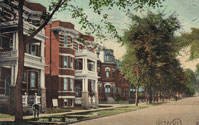

The Queen's Own Rifles, Jarvis Street, Toronto and The Royal Canadian Yacht Club
Jason Tiller Collection
He decided that it was not the time to worry about valuables and he didn’t think the ship was going to sink, so he stepped outside. Peuchen considered it sad that he had to leave his “cheery room, cozy, large and comfortable as it was,” to go up top. The corridor was packed with passengers in life belts and some women were weeping. In a moment, Peuchen was back in his stateroom retrieving his lucky watch and favourite pearl pin, put three oranges in his pockets and closed the door for the last time. He left the tin box and presents that he had bought for his son and daughter behind, and continued heading for the grand staircase.
Once he was out on deck, he witnessed Captain Smith and Second Officer Charles Lightoller standing beside four lifeboats, with the covers removed. He overheard Lightoller remark, “We will have to get these masts out of these boats and also the sail.” Extremely handy around boats, Peuchen took it upon himself and jumped into Lifeboat 2, and started to cut the lashings to remove the mast and sail. When this was done, the call went up for women and children to get in. All of a sudden, a crowd of stokers still dirty from shovelling coal in the depths of the ship, began to crowd around the boats. With loud commands from an officer, most likely Chief Officer Henry Tingle Wilde drove them clear of the deck. Peuchen had total admiration for the officer`s firmness and would later describe it as “a splendid act”.
The call went up once again for women and children only, but most passengers were not enthusiastic about it, as they were not willing to depart the warmth and security of the huge liner. They believed the same way Charles Hays did, that the ship was good for several hours. Peuchen assisted in getting women and children into the boat, and then removed the mast and sail from both boats 4 and 6.
At 1:10 am, Lifeboat 6 was lowered from the port side with twenty women and two crewman that Peuchen and the officers had loaded, however the boat could hold sixty people. After being lowered down a few decks, Quartermaster Robert Hichens who was at the helm at the time Titanic collided with the iceberg, called up “I can’t manage this boat with only one seamen”. But no crewmen were around, so Peuchen stepped forward to offer his assistance. “If you like, I will go.” “Are you a seamen?”asked Second Officer Charles H. Lightoller. “I am a yachtsman and can handle a boat with an average man”, replied Peuchen. “If you’re sailor enough to get out on that fall you can go down”, Peuchen just three days short of his 53rd birthday and former vice commodore of the Royal Canadian Yacht Club, swung himself out on the forward fall and slid down into the boat.
It is at this time, that Peuchen may have lost his wallet which fell into the sea. As soon as he was in the boat, Hichens wasted no time in issuing an order to Peuchen, to find the boat’s plug and put it in. Peuchen couldn’t find it in the dark, so he went back to where Hichens was waiting to release the falls as soon as the boat hit the water and suggested to Hichens that he put the plug in, while Peuchen undid the shackles. As soon as the plug was in, Hichens rushed back to the stern. “Hurry up”, he told Peuchen. “This boat is going to founder.” Peuchen thought the plug hadn’t been put in, but then he realized Hichens was referring to the Titanic.
Hichens feared that this yachtsman was trying to take charge, so he asserted his authority. “I am put in charge of the boat. You go and do what you are told to do.” Peuchen then sat down beside Frederick Fleet, the lookout that was on duty at the time who spotted the iceberg and telephoned the bridge to warn them “Iceberg, right ahead!” “We rowed away like good fellows”, Peuchen would later recall. Ten minutes later, Peuchen suggested that Hichens allow one of the woman to steer, so he could row. Hichens erupted at this and yelled at Peuchen, “I am in charge of this boat!” “It’s your job to keep quiet and row!”
Peuchen asked Hichens to row back and look for survivors, but Hichens cut him off. His responsibility, he replied, was to the living, not to the dying and the dead. “It’s our lives now! Not theirs. There’s only a lot of stiffs out there,” Hichens remarked.
For the better part of the night, Peuchen and Hichens argued back and forth, since Hichens felt threatened by Peuchen’s military standing and knowledge of boats, announcing that he was in charge and it was Peuchen’s job to row. After a while, Peuchen finally decided he had enough; “It is no use arguing with that man at all”, he remarked to the ladies. “It is best not to discuss matters with him.”
The R.M.S. Carpathia which answered the Titanic’s distress call at 12:25 am, arrived on the scene at 4:00 am. Approximately at 8:00 am, Lifeboat 6 which was one of the last boats was brought alongside and Peuchen climbed up the side of the ship. Peuchen shared a cabin with three other people and wore the same clothes he had on, while aboard the Titanic. A far greater discomfort was the hostility being felt by many of the women that were grieving. “Married women were envious when they saw that I, a strong man had been saved, while their husbands, sons and brothers had gone down.” Peuchen obtained a certificate from Lightoller while on board the Carpathia, stating that he had been ordered into Lifeboat 6 by him, which helped to delay some of the resentment. Mrs. Clara Hays supposedly apologized to Peuchen for her former “secret attitude” toward him.
The Carpathia arrived in New York on April 18th. Peuchen was met by his wife, two children and brother-in-law. After being interviewed by many reporters to whom he repeated his story again and again, Peuchen made it home on Saturday April 20th and greeting the Peuchen’s was a large headline in Saturday’s Toronto World “Major Peuchen Blames Captain Who Went Down With His Ship.” The article below the headline repeated Peuchen’s account of the disaster and his accusations of “criminal carelessness.” Peuchen’s arrival at home was to be short lived, as a telegram awaited him at his residence, of 599 Jarvis St. It was from Senator William Alden Smith and it asked if Peuchen would give testimony before the Senate Inquiry in Washington. Peuchen was utterly exhausted, but he made arrangements to leave the following day.
Before Peuchen left for Washington by train, he found time to talk to one more reporter about his experiences. Peuchen told the reporter from the Globe, “I am going to Washington this afternoon at great personal inconvenience. I am not compelled to go, as Senator Smith’s telegram is not in the form of a summons, but I am going in the future interests of the world’s traveling public.” Peuchen was then asked if he had anything further to say about his experiences on the night of April 14th. “There is no use in my rehearsing to you my story. But I am surprised at the statements being made by people in this city and elsewhere regarding my conduct. I cannot understand them. They suggest in their remarks that I did not act as I should have done and that I should have drowned with the other men. I do not see how they could make such statements. I did all I could do. I helped the men with the boats. What would they have done in the same circumstances?”
Peuchen then commented that many of the interviews that the newspapers had published were unfair. “It has been stated that I said harsh things about Captain Smith. I have never made any comment against Captain Smith, with the exception that I said I thought more precautions should have been taken in view of the advice received regarding the dangerous ground the vessel was approaching. I never called Mr. Ismay a coward. He was ungrateful. I have never made an unkind remark about the captain, and any paper that is published otherwise misquoted me.”
After surviving the Titanic disaster, Peuchen suffered a lot of criticism and scorn from both local society and media, when he got back to Toronto, just because he survived while others didn’t. He was first regarded as a hero, but as more news started to trickle in about his supposed conduct, people turned against him. One newspaper taunt that circulated was, “He said he was a yachtsman to get himself off the ship and if it had been a fire, he would have said he was a fireman.” The Toronto Mail discredited him, since he talked too much. He put himself in the position of a man who had to defend himself before the necessity for the defence was apparent.” When people saw Peuchen walking on the street, they would cross over to the other side so they didn`t have to walk beside him and people yelled, “Peuchen, you bastard!”
On April 23rd, at 3:55 pm, Peuchen took the stand and told his story, with his wife, Margaret sitting beside him, who by now had heard the story many times. At the end of his testimony, he asked to make a statement and in it, he wanted to set the record straight; “I have been quoted as making a great many statements or as saying several things, and I would like to just put this straight. I do not criticize Capt Smith, but I do criticize the policy and methods pursued by the company, for I feel sure that in this case caution would have been of every virtue and would have averted the terrible calamity. I have been given the credit of saying many things which are absolutely untrue and I wish to state that I have not said any personal or unkind thing about Capt. Smith. I have been quoted as saying some very unkind things about the late captain, but I assure you I have never made any statement of that kind.”
Peuchen then went on to say: “I am here, sir, more on account of the poor women that came off our boat. They asked me if I would not come and tell this court of inquiry what I had seen, and when you wired me, sir, I came at once, without being pressed in any way, simply to carry out my promise to the poor women on our boat.” His testimony was well regarded and very valuable to Senator Smith. Peuchen was the only Canadian to testify.
On May 21st, Peuchen was promoted to Lieutenant-Colonel of the Queen’s Own Rifles of the First Battalion and received the Officer’s Long Service Decoration, but not in command of the entire regiment which had been expected.
In 1914, Peuchen retired from Standard Chemical to command the Home Battalion of the Queen’s Own Rifles and was commander for approximately the first year of World War 1. Peuchen was placed on the reserve list of officers in 1915. From 1915-1918, he lived in London, as his son was a Lieutenant in the Royal Field Artillery regiment and his daughter was a nurse in England who ended up marrying an officer from the same regiment. Upon returning to Canada after the war, Peuchen suffered more backlash since he had now survived the Titanic and the War.
In 1920 up until 1929, Peuchen and the McLaren Lumber Company began to negotiate a dam project for Oldman River in southwest Alberta, Canada but it was never completed due to winter ice floe delays, decreases in the price of lumber and cost overruns. It was apparently abandoned, a sign of financial woes that continued to haunt Peuchen.
Peuchen sustained financial losses in 1924, due to overspending by Sir Henry Pellatt on Casa Loma (Canada’s only castle in Toronto). That same year, he was recorded as living at Queen Anne’s Mansions in St James Park, London, England. In Peuchen’s final years, he apparently lived in a company dormitory owned by Standard Chemical, in Hinton, Alberta. Peuchen returned to Toronto in late July 1929. In early November, Peuchen came down with chronic myocarditis (inflammation of the heart muscle) and if that wasn’t fatal enough, developed pneumonia on December 3rd. He passed away at his home, 105 Roxborough St East on December 7, 1929 at the age of 70. He was buried at Mount Pleasant Cemetery, two days later. However, it’s almost like he had a broken heart from all the scorn that he’d received.
In 1987, Arthur Peuchen’s wallet was salvaged from the debris field. In it was a travellers certificate, his calling card and three streetcar tickets.
- - - O - - -
Mary Fortune
Mary Fortune (nee McDougald) was born in Chinguacousy Township, Peel County, Ontario on Tuesday May 12th, 1851 to John McDougald and his wife Mary. The family moved to Portage La Prairie, Manitoba sometime after Mary was born. She grew up there with her 14 brothers and sisters. She married Mark Fortune, a resident of Winnipeg, Manitoba and they had six children. The Fortune family with the exception of two of the children who had decided to stay home, had been on a grand tour of Europe, traveling with Hugo Ross, Thomson Beattie and Thomas McCaffry. Their final destination in Europe was Paris and when they arrived there, they cancelled their plans to sail home on the Mauretania which would have been later and booked passage on the maiden voyage of a prominent new ocean liner.
Mary boarded the Titanic as a first class passenger with her husband, three daughters Alice Elizabeth, Ethel Flora and Mabel Helen, and their son Charles Alexander. Their tickets cost them 263 pounds and they occupied cabins C23/25/27. Mary and her three daughters were rescued in lifeboat 10, but sadly Mark and Charles both perished in the disaster. After the disaster, Mary returned to Winnipeg until she moved to Toronto to live with Ethel. She never remarried and died on March 8th, 1929. Her cause of death was not disclosed. She is in a mausoleum in Mount Pleasant Cemetery.
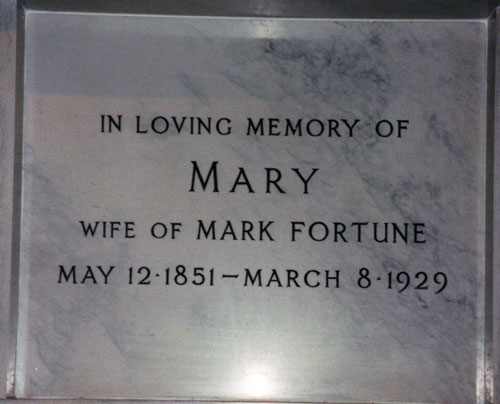
Photo by Jason D. Tiller
- - - O - -
Ethel Fortune
Ethel Flora Fortune was born on Saturday September 22nd, 1883 in Winnipeg, Manitoba, the second oldest daughter to Mark and Mary Fortune. Ethel Fortune was engaged to a Crawford Gordon in 1912, a rising banker in Toronto and agreed to postpone her wedding to shop for a trousseau in Europe and accompany her younger siblings. Ethel was in lifeboat 10, along with her mother, Mary and two sisters, Alice and Mabel. After the Titanic had gone down, Ethel was forever haunted by one last frightening glimpse of her brother Charles in the water, “life jacket on, struggling to stay afloat”. But there was no way she could have seen him, as it was just too dark. The image of her brother drowning was more than likely her imagination, but the thought of Charles thrashing about in the water pleading for someone to help him haunted Ethel for the rest of her life.
Ethel married Crawford Gordon in 1913 and seven years later, they moved to Jamaica and then onto London, England, where Crawford was appointed Manager of the Canadian Bank of Commerce. They had two sons and their oldest, Crawford Gordon Jr. was the head of A.V. Roe, which produced Canada`s legendary Avro Arrow in the 1950’s, the most advanced military aircraft in the world at the time. Ethel was a very active worker for the troops in World War II. Her husband, Crawford passed away in 1957. On Tuesday March 21, 1961, Ethel passed away at her home, 1 Clarendon Ave in Toronto. The cause of her death was not disclosed. She is buried with her husband in Mount Pleasant Cemetery.

Photo by Jason D. Tiller
- - - O - -
Emma Bliss
Emma Bliss (nee Junod) was born in Rolle, Switzerland on May 9, 1866. Her previous ship had been the Majestic. She was a first class stewardess and received monthly wages of 3 pounds. Emma was rescued in Lifeboat 15.
After the disaster, she moved to Toronto and married Ernest John Bliss. On April 15th, 1939 she along with Elizabeth Mellinger, Madeleine Mann (nee Mellinger) and Samuel John Collins met for a Titanic reunion at the Royal York Hotel, Toronto. While in hospital on March 11th, 1959, Emma was invited to watch “A Night to Remember”. She could not help but cry, as she pointed towards the television. Just over three months later, on June 17th, Emma Bliss passed away at a nursing home and was buried two days later at Prospect Cemetery. The cause of her death is not listed on the death certificate.
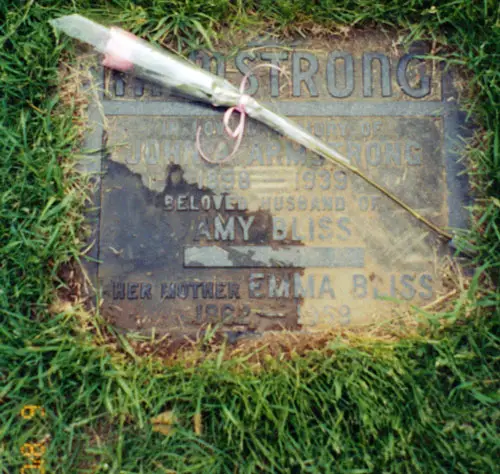
Photo by Jason D. Tiller
- - - O - -
Victor Francis Patrick Sunderland
 Victor Sunderland was born on Thursday March 17th, 1892 to James William Sunderland and Annie Foley in West Ham, London, England. He embarked the Titanic at Southampton and was a third class passenger. His ticket cost 8 pounds 1 shilling and his cabin was on G deck. He was a resident of London, England and was traveling to Cleveland, Ohio to stay with his uncle, J.P. Foley.
Victor Sunderland was born on Thursday March 17th, 1892 to James William Sunderland and Annie Foley in West Ham, London, England. He embarked the Titanic at Southampton and was a third class passenger. His ticket cost 8 pounds 1 shilling and his cabin was on G deck. He was a resident of London, England and was traveling to Cleveland, Ohio to stay with his uncle, J.P. Foley.
On the night of the collision, Victor and his two cabin mates were in their cabin smoking. He had on his trousers, while his vest and coat were hanging on a rack. Just before midnight, he felt a slight jar and heard a noise “similar to that (of) a basket of coal would make if dropped on an iron plate”. He and six others went to see what had happened and they made their way up to the companion way, to the main deck but a steward told them to go back. They noticed ice on the deck, however the steward said nothing was wrong, so back to their cabin they went.
Sunderland and his cabin mates lay on the bunks again and smoked for another quarter of an hour. All of a sudden, water started pouring in under the door. They knew instantly that something was very wrong and the three of them ran back up to the main deck, while the other men continued to lay in bed. Sunderland presumed they had drowned.
Sunderland was instructed to return to his cabin, to retrieve his lifebelt. They went back, but discovered their room was already under water. So they ran aft between decks and up to the main deck. They located a Catholic priest praying and a crowd of both men and women kneeling. Others were running about, it was clear that the panic was building. Sunderland and his companions separated; they went to the railing at the stern, while Sunderland made his way to the mid promenade deck and then up to the boat deck.
He discovered the boat deck to be crowded on the starboard side. The officers were filling the boats with women and children and lowering them away. Sunderland stated that standing near him were the Straus’. One of the officers was attempting to convince them to get into a boat, but Ida Straus said “Let me have my husband. When informed that only she could get into the boat, she responded, “Then I will die with him”. Whether Sunderland witnessed this or not is not definite, he also supposedly saw an officer firing a weapon into the air at least twice and shooting a man who did not want to get out of a lifeboat.
Sunderland began to search for a lifebelt. He noticed a steward in a boat with three lifebelts and asked him for one, but the steward rebuffed him. Sunderland then asked a crewmember if he knew where he could find a lifebelt, but the crewmember had no idea. Things were now starting to become more and more serious for those people still on board; the ship was starting to list to port and just about all the boats on the starboard side were gone. The passengers were attempting to move to the port side, but were kept back by crewmembers.
Sunderland stayed near to the bow, where Second Officer Charles Lightoller and several firemen were attempting to launch Collapsible B. Water was rapidly coming towards him and the bow of the ship was beginning to sink at a even faster rate. Firemen began to jump overboard and Sunderland followed them. He swam away and discovered Boat B floating next to the sinking liner, washed overboard. He clutched onto it, as it went past the forward funnel and moments later, the hawsers that attached the funnel to the deck snapped one by one and down it came. Sunderland speculated that the ship broke in two at that time.
Sunderland and approximately 30 other people climbed onto Collapsible B, while many others were kept away to keep the boat from overloading. He had water up to his waist. Someone shouted out how many Catholics were aboard, but Sunderland wasn’t one of them; he was a Presbyterian. Whoever it was, began to recite the Lord’s Prayer and The Hail Mary, while others followed.
Approximately at 4 am, the rescue ship Carpathia was seen and Lightoller signalled Boat 12 to take them off. Sunderland was the fifth person to disembark Boat B and once on the Carpathia, he recalled being provided cold coffee.
Upon arriving in New York, Sunderland was escorted to the Salvation Army home where he was fed and given clothes. After that, he was hospitalized very briefly at St. Vincent’s Hospital where he stayed until April 20th. When he was discharged from hospital, he made his way to the White Star offices to try to recover money lost in the disaster. He did this every day until April 24th and he as well “saw the sights”. He boarded a train to Cleveland and appeared at his uncle’s home unexpectedly on April 26th.
It is unknown how long Victor Sunderland remained in Cleveland, but on April 7th, 1914 he married a Scottish young lady whose name was Anna May McNaughton, in Toronto who was just a year younger than him. Before the wedding, Sunderland was living at 115 Pape Ave and his bride was residing at 26 Morse St, but after the ceremony, Sunderland moved to his new bride’s home. On November 11th of that year, Sunderland enlisted to fight in the war. He had traveled to Kingston, Ontario to sign up. Sunderland had experience being in the military, as he had been a member of the 3rd Issac Regiment for one year.
Sunderland fought with the West York Regiment and received a medal for his efforts. He was discharged on September 20th, 1918 and returned home to his wife the following February. He was a Master Plumber by trade and worked in that capacity, until his retirement in 1939.
Not much else is known about Victor Sunderland after that. He and Anna for whatever reason seemed to have had no children. Victor Sunderland passed away on August 21, 1973 at the age of 81 and is buried in St. John’s Norway Cemetery. Strangely enough, Anna is not buried with him.

Courtesy of D. Jackson – Jason D. Tiller collection
- - - O - -
John (Samuel) Collins
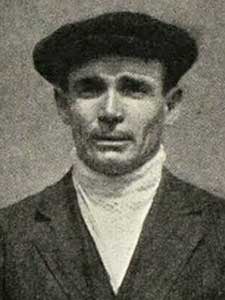
The last but not least survivor to live in Toronto, was John (Samuel) Collins. Collins was born in Ramsgate, Kent on the coast of England, on January 19, 1874 to John Collins and Mary Lawrence. On December 27, 1890 he enlisted in the Royal Marines. Being 16 years of age at the time he was underage, but was retained and transferred from Walmer to Chatham on January 1, 1891 for further training. However, he was discharged as “invalided” a year and two months later on March 8, 1892. It is speculated that he re-enlisted to serve in the Boer War.
On March 16, 1902 Collins wed Harriet Farley (1885-1967) who was only 17 years of age, in Ramsgate. Collins listed his occupation as ‘groom’. It has been said that John and Harriet had children, but so far I have not found any evidence to support this.
Collins signed on to the Titanic on April 6, 1912. He was 38 years of age. His previous ship was the Highland Laddie. His monthly wages were 6 pounds. Collins escaped in Lifeboat 1 (the emergency boat) and was later summoned to testify at the British Inquiry. It is unclear what his movements were, prior to getting into the lifeboat. Lifeboat 1 had been dubbed “the money boat”, due to accusations of bribery not to return to rescue more survivors.
Collins testified that Chief Officer Murdoch instructed him to get into the lifeboat. (There are many examples of crew referring to First Officer Murdoch as Chief Officer due to the fact there was a late change of officer ranks and Murdoch possibly still had chief officer stripes on his coat as the change was so late.) He testified that Murdoch instructed two female and two male passengers into the boat and then Murdoch instructed to the boat to "lay handy for further orders."
He insisted that no one proposed returning to collect survivors in the water and that the cries of those in the water lasted for around ten minutes. He refuted any claim of bribery and that any discussions to return to collect survivors were halted after concerns were expressed regarding the suction of the sinking vessel.
In 1914, Collins left Ramsgate for Canada and enlisted with the Canadian Expeditionary Force (CEF). He served for approximately one year and was awarded a campaign medal. Collins went under the alias Samuel when he returned to Europe, which is a complete mystery as to why and has caused much confusion amongst the family. Collins married a second time on June 25, 1916 to Florence Milly Grant (nee Green 1883-1980), in London. He gave his name as John Lawrence Collins (Lawrence was his mother’s maiden name).
There is no evidence that John and Harriet ever divorced. It seems as though Collins wanted to immigrate to Canada, however, Harriet wished to continue to reside in Ramsgate. John and Florence did indeed immigrate to Canada, sometime after the wedding and resided in Toronto, Ontario.
Florence had two sons (one being born in June 1912) from a previous marriage, with a medical practitioner. She gave birth to two daughters, Mary Ypres Collins (March 1, 1918 – June 16, 1999) and Doris Mons Collins (August 1, 1919 – September 27, 1990).
Harriet meanwhile (John’s estranged wife) remarried in 1927, to George Henry Page (1885-1975) and bore a daughter, Laura born in 1924 and possibly other children as well. Harriet helped raise George’s son, George Henry Thomas Page born in 1911.
On April 15, 1939 (27 years after the sinking), Collins, along with fellow survivors Elizabeth Mellinger, Madeline Mann (nee Mellinger) and Emma Bliss got together for a Titanic reunion dinner, at the Royal York Hotel, Toronto. According to Collins’ grandson, the reunions were held annually.
After being ill for the last five months of his life, John Collins passed away from stomach cancer on September 28, 1950 at Sunnybrook Hospital at the age of 76. He is buried in Pine Hills Cemetery, Toronto, in the Veterans Section.
- - - O - -
John Hugo Ross
While on a walk through Mount Pleasant Cemetery looking for a particular grave last October, I stumbled upon this memorial to John Hugo Ross. Ross’s father is also buried at this location. This memorial has been unknown in Titanic circles until now, so it was an amazing find; I honestly just about fell over myself, that’s how excited I was!
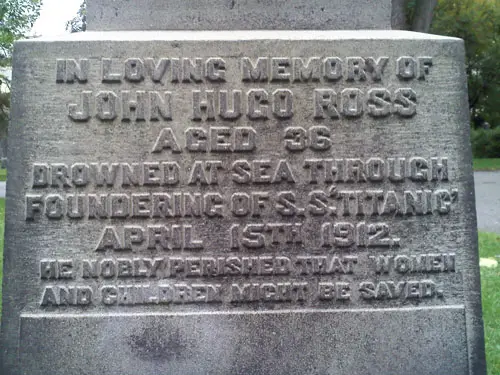
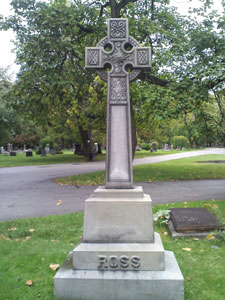
Photos by Jason D. Tiller
These seven people (including John Hugo Ross), and their shipmates, were just like everybody else, nothing special or extraordinary about them. They just happened to find themselves on an ocean liner, while on her maiden voyage struck an iceberg in the North Atlantic and sank with the loss of almost 1,500 people one hundred years ago. May they rest in peace and never be forgotten.
Jason D. Tiller
April 1, 2012, (revised 15 April 2022)
Jason D. Tiller is a Titanic Historian/Researcher/Author living in Niagara Falls, with his fiancée. He has been fascinated with the Titanic, since he was 11 years old. His dream came true, when he got the chance to work as the second Titanic Historian at a Titanic Artifact Exhibition, which was in Toronto from September 1999 until February 2000. Titanic is his passion. He is currently writing a full scale biography on the life and times of Lieut. Col Arthur G. Peuchen for publication. One of these days, he hopes to fulfill another dream which is to visit the wreck.

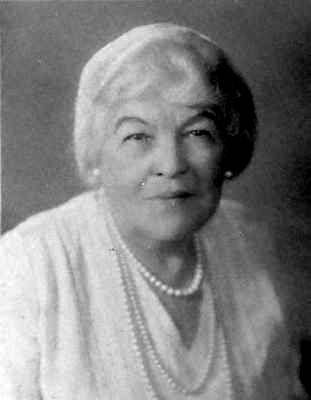

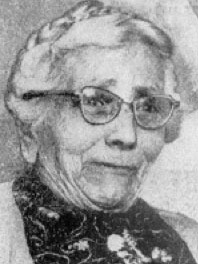
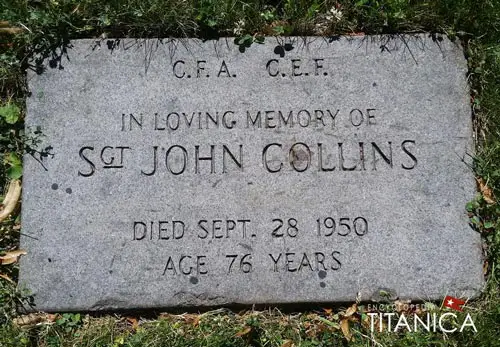

Comment and discuss